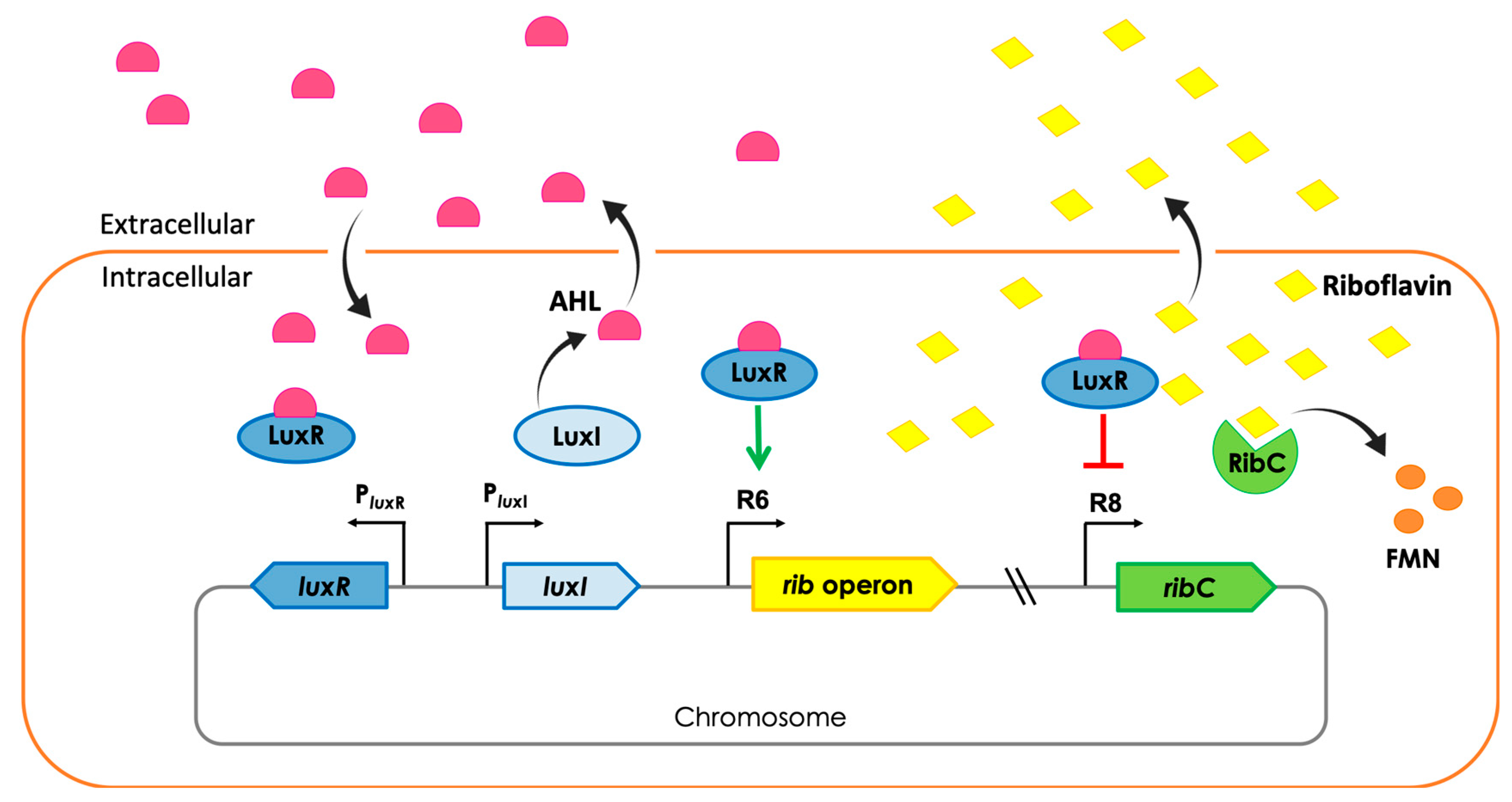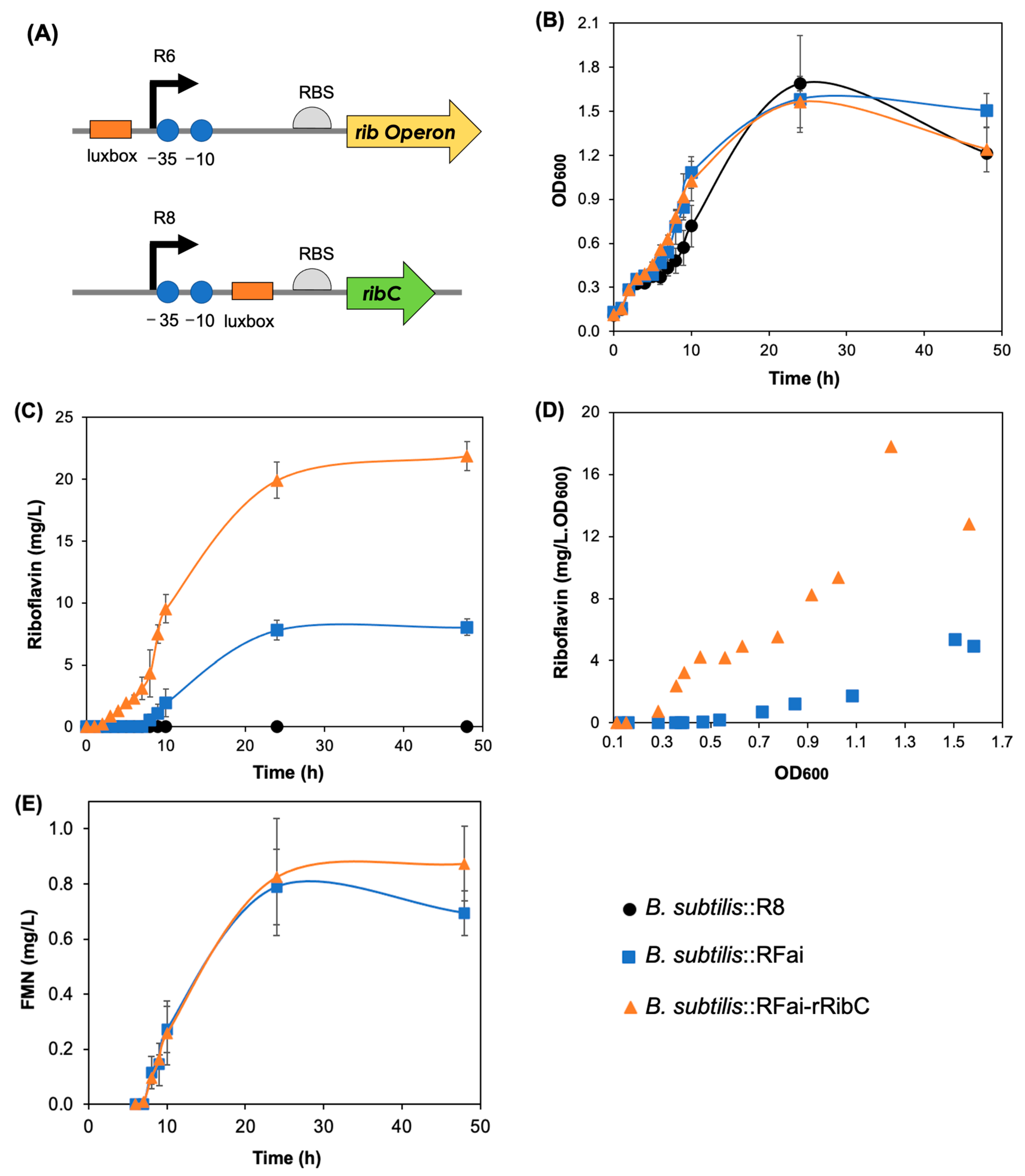Expanding the Functionality of an Autoinduction Device for Repression of Gene Expression in Bacillus subtilis
Abstract
1. Introduction
2. Results and Discussion
3. Materials and Methods
3.1. Bacterial Strains and Growth Conditions
3.2. Plasmid Construction and Gene Editing
3.3. Riboflavin Production and Growth Conditions
3.4. Growth Measurement
3.5. Flavin Identification and Quantification
Supplementary Materials
Author Contributions
Funding
Institutional Review Board Statement
Informed Consent Statement
Data Availability Statement
Conflicts of Interest
References
- Venayak, N.; Anesiadis, N.; Cluett, W.R.; Mahadevan, R. Engineering Metabolism through Dynamic Control. Curr. Opin. Biotechnol. 2015, 34, 142–152. [Google Scholar] [CrossRef]
- Xu, P. Production of Chemicals Using Dynamic Control of Metabolic Fluxes. Curr. Opin. Biotechnol. 2018, 53, 12–19. [Google Scholar] [CrossRef]
- Shen, X.; Wang, J.; Li, C.; Yuan, Q.; Yan, Y. Dynamic Gene Expression Engineering as a Tool in Pathway Engineering. Curr. Opin. Biotechnol. 2019, 59, 122–129. [Google Scholar] [CrossRef]
- Corrêa, G.G.; Lins, M.R.D.C.R.; Silva, B.F.; de Paiva, G.B.; Zocca, V.F.B.; Ribeiro, N.V.; Picheli, F.P.; Mack, M.; Pedrolli, D. A Modular Autoinduction Device for Control of Gene Expression in Bacillus Subtilis. Metab. Eng. 2020, 61, 326–334. [Google Scholar] [CrossRef] [PubMed]
- Mack, M.; van Loon, A.P.; Hohmann, H.P. Regulation of Riboflavin Biosynthesis in Bacillus Subtilis Is Affected by the Activity of the Flavokinase/Flavin Adenine Dinucleotide Synthetase Encoded by RibC. J. Bacteriol. 1998, 180, 950–955. [Google Scholar] [CrossRef] [PubMed]
- Langer, S.; Hashimoto, M.; Hobl, B.; Mathes, T.; Mack, M. Flavoproteins Are Potential Targets for the Antibiotic Roseoflavin in Escherichia Coli. J. Bacteriol. 2013, 195, 4037–4045. [Google Scholar] [CrossRef]
- Winkler, W.C.; Cohen-Chalamish, S.; Breaker, R.R. An MRNA Structure That Controls Gene Expression by Binding FMN. Proc. Natl. Acad. Sci. USA 2002, 99, 15908–15913. [Google Scholar] [CrossRef] [PubMed]
- Boumezbeur, A.H.; Bruer, M.; Stoecklin, G.; Mack, M. Rational Engineering of Transcriptional Riboswitches Leads to Enhanced Metabolite Levels in Bacillus Subtilis. Metab. Eng. 2020, 61, 58–68. [Google Scholar] [CrossRef] [PubMed]
- Pedrolli, D.B.; Kuhm, C.; Sevin, D.C.; Vockenhuber, M.P.; Sauer, U.; Suess, B.; Mack, M. A Dual Control Mechanism Synchronizes Riboflavin and Sulphur Metabolism in Bacillus Subtilis. Proc. Natl. Acad. Sci. USA 2015, 112, 14054–14059. [Google Scholar] [CrossRef] [PubMed]
- Bao, S.-H.; Jiang, H.; Zhu, L.-Y.; Yao, G.; Han, P.-G.; Wan, X.-K.; Wang, K.; Song, T.-Y.; Liu, C.-J.; Wang, S.; et al. A Dynamic and Multilocus Metabolic Regulation Strategy Using Quorum-Sensing-Controlled Bacterial Small RNA. Cell Rep. 2021, 36, 109413. [Google Scholar] [CrossRef] [PubMed]
- Altenbuchner, J. Editing of the Bacillus Subtilis Genome by the CRISPR-Cas9 System. Appl. Environ. Microbiol. 2016, 82, 5421–5427. [Google Scholar] [CrossRef] [PubMed]
- Engler, C.; Marillonnet, S. Golden Gate Cloning. Methods Mol. Biol. 2014, 1116, 119–131. [Google Scholar] [CrossRef] [PubMed]
- Lins, M.R.D.C.R.; da Silva Amorim, L.A.; Corrêa, G.G.; Picão, B.W.; Mack, M.; Cerri, M.O.; Pedrolli, D.B. Targeting Riboswitches with Synthetic Small RNAs for Metabolic Engineering. Metab. Eng. 2021, 68, 59–67. [Google Scholar] [CrossRef] [PubMed]


| ID | Sequence | Use |
|---|---|---|
| gRNA(truB 848)_fw | TACGGCTTGGCGATCTATTTCCCT | gRNA forward oligo |
| gRNA(truB 848)_rv | AAACAGGGAAATAGATCGCCAAGC | gRNA reverse oligo |
| truB-seq.hom(SfiI)_fw | AAGGCCAACGAGGCCGTATGATAACCATTGAAGACATTGCCC | truB PCR forward primer |
| truB-seq.hom(BsaI)_rv | TCTGGGTCTCTCTATTGTTCGCTTTTTTGCATCAATACTTTTGCCGGCTTTAACAGCCCTTTTTTTGCAGGATGAGGGAAATAGATCGCCAAGCATGTTCCGGATTCAGTAAAGACGGC | truB PCR reverse primer |
| luxbox_ribC(BsaI)_fw | GCTAGGTCTCAATAGACCTGTAGGATCGTACAGGTAAAAAAGGTGACCGTTCTGTGAAGAC | R8 promoter forward primer |
| luxbox_ribC(SfiI)_rv | AAGGCCTTATTGGCCTGCTCCGTTAATTTTTCTACCATTGTG | R8 promoter reverse primer |
| R8 promoter sequence | GAGCAGTTTTCTGAAATGACAAGTGGAGACCGTATTGCCGTCTTTACTGAATCCGGAACCTGCTTGGCGATCTATTTCCCTCATCCTGCAAAAAAAGGGCTGTTAAAGCCGGCAAAAGTATTGATGCAAAAAAGCGAACAATAGACCTGTAGGATCGTACAGGTAAAAAAGGTGACCGTTCTGTG | R8 promoter complete sequence |
Disclaimer/Publisher’s Note: The statements, opinions and data contained in all publications are solely those of the individual author(s) and contributor(s) and not of MDPI and/or the editor(s). MDPI and/or the editor(s) disclaim responsibility for any injury to people or property resulting from any ideas, methods, instructions or products referred to in the content. |
© 2022 by the authors. Licensee MDPI, Basel, Switzerland. This article is an open access article distributed under the terms and conditions of the Creative Commons Attribution (CC BY) license (https://creativecommons.org/licenses/by/4.0/).
Share and Cite
Silva, B.F.; Corrêa, G.G.; Zocca, V.F.B.; Picheli, F.P.; Lins, M.R.C.R.; Pedrolli, D.B. Expanding the Functionality of an Autoinduction Device for Repression of Gene Expression in Bacillus subtilis. Int. J. Mol. Sci. 2023, 24, 84. https://doi.org/10.3390/ijms24010084
Silva BF, Corrêa GG, Zocca VFB, Picheli FP, Lins MRCR, Pedrolli DB. Expanding the Functionality of an Autoinduction Device for Repression of Gene Expression in Bacillus subtilis. International Journal of Molecular Sciences. 2023; 24(1):84. https://doi.org/10.3390/ijms24010084
Chicago/Turabian StyleSilva, Bruna F., Graciely G. Corrêa, Vitória F. B. Zocca, Flavio P. Picheli, Milca R. C. R. Lins, and Danielle B. Pedrolli. 2023. "Expanding the Functionality of an Autoinduction Device for Repression of Gene Expression in Bacillus subtilis" International Journal of Molecular Sciences 24, no. 1: 84. https://doi.org/10.3390/ijms24010084
APA StyleSilva, B. F., Corrêa, G. G., Zocca, V. F. B., Picheli, F. P., Lins, M. R. C. R., & Pedrolli, D. B. (2023). Expanding the Functionality of an Autoinduction Device for Repression of Gene Expression in Bacillus subtilis. International Journal of Molecular Sciences, 24(1), 84. https://doi.org/10.3390/ijms24010084







